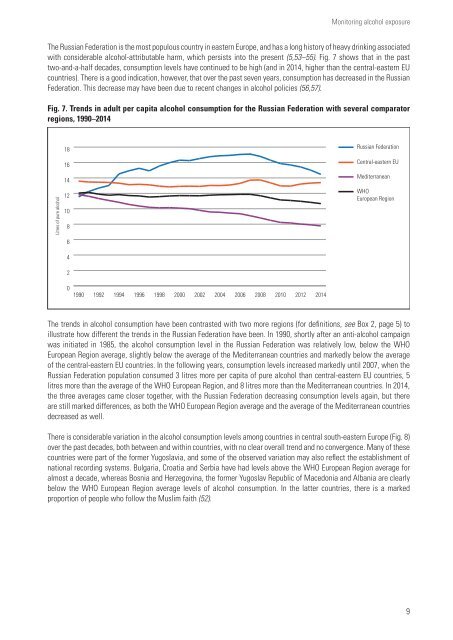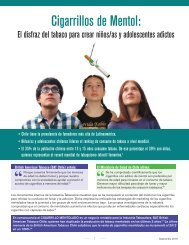Public health successes and missed opportunities
Public-health-successes-and-missed-opportunities-alcohol-mortality-19902014
Public-health-successes-and-missed-opportunities-alcohol-mortality-19902014
Create successful ePaper yourself
Turn your PDF publications into a flip-book with our unique Google optimized e-Paper software.
Monitoring alcohol exposure<br />
The Russian Federation is the most populous country in eastern Europe, <strong>and</strong> has a long history of heavy drinking associated<br />
with considerable alcohol-attributable harm, which persists into the present (5,53–55). Fig. 7 shows that in the past<br />
two-<strong>and</strong>-a-half decades, consumption levels have continued to be high (<strong>and</strong> in 2014, higher than the central-eastern EU<br />
countries). There is a good indication, however, that over the past seven years, consumption has decreased in the Russian<br />
Federation. This decrease may have been due to recent changes in alcohol policies (56,57).<br />
Fig. 7. Trends in adult per capita alcohol consumption for the Russian Federation with several comparator<br />
regions, 1990–2014<br />
Litres of pure alcohol<br />
18<br />
16<br />
14<br />
12<br />
10<br />
8<br />
6<br />
4<br />
2<br />
Russian Federation<br />
Central-eastern EU<br />
Mediterranean<br />
WHO<br />
European Region<br />
0<br />
1990<br />
1992<br />
1994<br />
1996<br />
1998<br />
2000<br />
2002<br />
2004<br />
2006<br />
2008<br />
2010<br />
2012<br />
2014<br />
The trends in alcohol consumption have been contrasted with two more regions (for definitions, see Box 2, page 5) to<br />
illustrate how different the trends in the Russian Federation have been. In 1990, shortly after an anti-alcohol campaign<br />
Mediterranian c.<br />
was initiated in 1985, the alcohol consumption level in the Russian Federation was relatively low, below the WHO<br />
WHO Euro<br />
European Region average, slightly below the average of the Mediterranean countries <strong>and</strong> markedly below the average<br />
Central Eastern countries in EU<br />
of the central-eastern EU countries. In the following years, consumption levels increased markedly until 2007, when the<br />
Russian Federation population consumed 3 litres more per capita of pure alcohol than central-eastern EU countries, 5<br />
WHO Euro<br />
litres more than the average of the WHO European Region, <strong>and</strong> 8 litres more than the Mediterranean countries. In 2014,<br />
the three averages came closer together, with the Russian Federation decreasing consumption levels again, but there<br />
are still marked differences, as both the WHO European Region average <strong>and</strong> the average of the Mediterranean countries<br />
decreased as well.<br />
There is considerable variation in the alcohol consumption levels among countries in central south-eastern Europe (Fig. 8)<br />
over the past decades, both between <strong>and</strong> within countries, with no clear overall trend <strong>and</strong> no convergence. Many of these<br />
countries were part of the former Yugoslavia, <strong>and</strong> some of the observed variation may also reflect the establishment of<br />
national recording systems. Bulgaria, Croatia <strong>and</strong> Serbia have had levels above the WHO European Region average for<br />
almost a decade, whereas Bosnia <strong>and</strong> Herzegovina, the former Yugoslav Republic of Macedonia <strong>and</strong> Albania are clearly<br />
below the WHO European Region average levels of alcohol consumption. In the latter countries, there is a marked<br />
proportion of people who follow the Muslim faith (52).<br />
9




